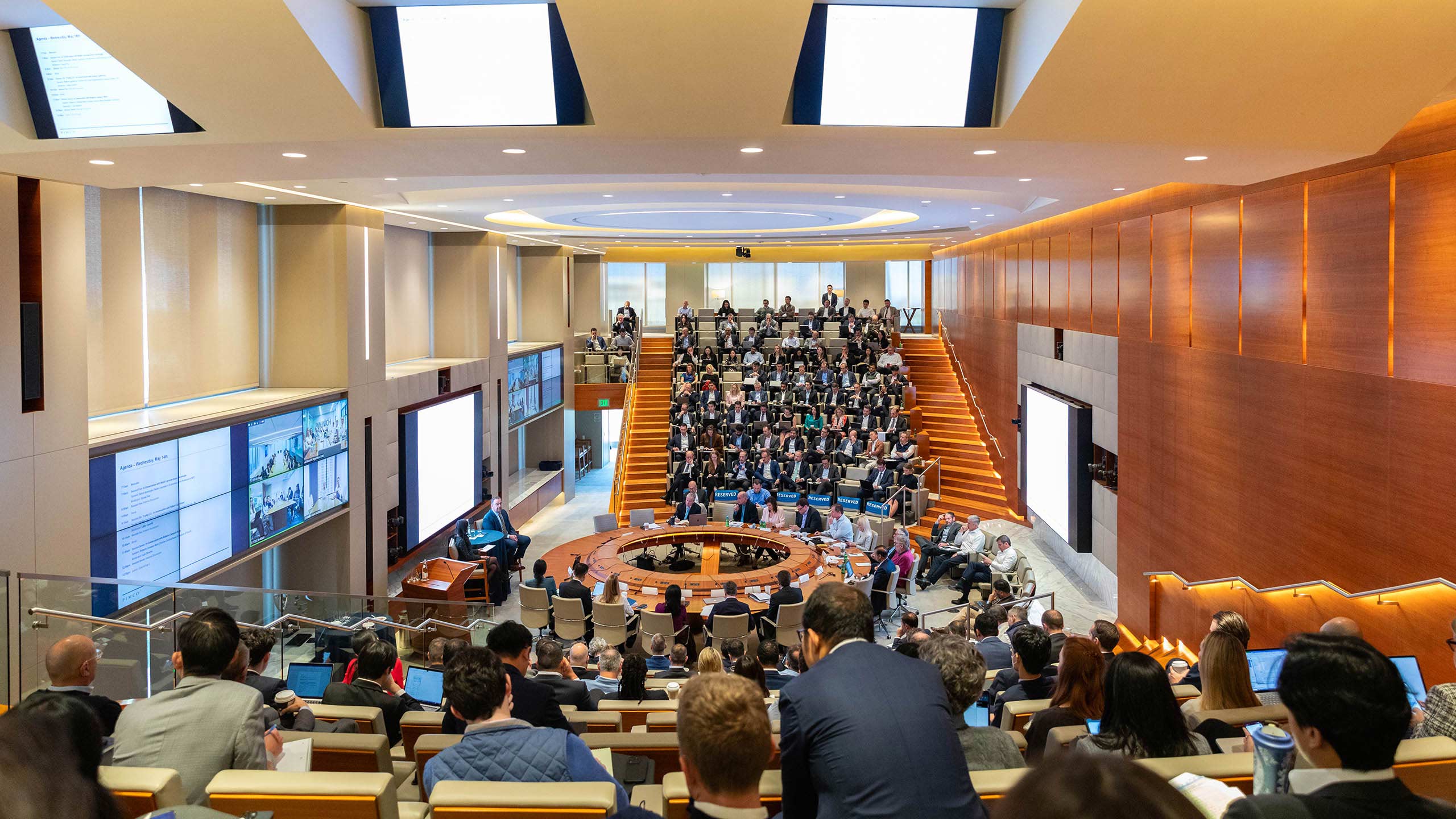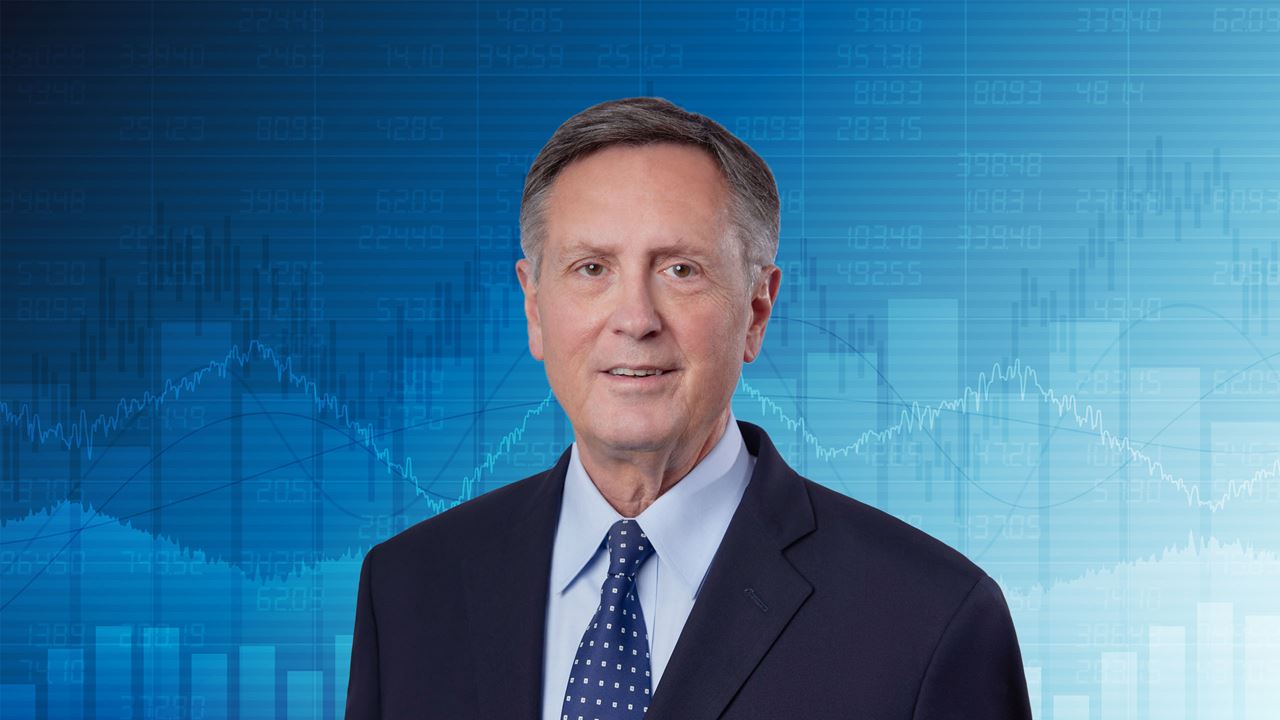

Economic outlook takeaways
- Clashing forces create winners and losers
A growing tension among three macro forces – trade frictions, the AI investment boom, and challenges to institutions including the Federal Reserve – could test conventional economic and investment frameworks, drive volatility, and widen the gap between winners and losers, both in the U.S. and globally. - Delayed tariff effects begin to bite
Economic growth has been surprisingly resilient, but that appears likely to change. After preemptive actions boosted global trade flows and goods production, many countries now face a transition, with mounting pressure from tariffs and constrained fiscal flexibility. In the U.S., we believe the main risk from tariffs isn’t a price adjustment – it’s that unemployment could rise. The Fed and other central banks have ample room for more interest rate cuts. - Tech investment provides support amid signs of weakness
Global data trends point to a weaker period ahead before targeted fiscal stimulus in some regions starts to kick in. At the same time, resilient tech investment, especially in the U.S. and China, is poised to continue, with potentially growing effects on productivity and the labor market.
Investment outlook takeaways
- Bond yields offer durable opportunities, while cash rates are poised to decline
Locking in today’s attractive starting bond yields can support strong returns and income potential in the years ahead across a variety of economic scenarios. With rates on cash-like investments likely to decline alongside central bank policy rates, we expect bonds to outperform. We favor short and intermediate bond maturities. - Global diversification can enhance outperformance potential
Investors can take advantage of today’s unusual abundance of global fixed income opportunities, with attractive real and nominal yields available in a variety of countries. Diversification across regions and currencies is an effective way to fortify portfolios and harvest sources of return. - Relative value can be a guide across the public–private credit continuum
The conventional divide between public and private credit is giving way to a more integrated view. We see a continuum of opportunity spanning across these markets that should be evaluated on differences in liquidity and economic sensitivity. We focus on high quality assets and see strong return potential in asset-based finance.
Economic outlook: A clash of forces tests conventional frameworks
The Trump administration aims to reshape the U.S.’s global role while improving the country’s trade balance. In previous Cyclical Outlooks, we argued that addressing these imbalances would require difficult-to-implement reforms in both the U.S. and its trading partners (for more, see our April 2025 Cyclical Outlook, “Seeking Stability”).
Since our last Cyclical Forum in March, the administration has enacted sweeping overhauls. The impact on the trade balance remains uncertain. However, we believe three forces – tariff effects, the technology investment boom, and challenges to institutions – will likely drive greater economic and capital market volatility within the U.S. and globally (for more, see our June 2025 Secular Outlook, “The Fragmentation Era”).
Tariff effects set to bite
Since President Donald Trump’s term began in January, the U.S. has raised tariffs on every major trading partner. The result has been the largest effective average U.S. tariff rate increase in over a century – from under 3% in 2024 to about 11% as of September 2025, according to the U.S. International Trade Commission. Tariffs remain an administration priority even as legal challenges could delay or disrupt implementation.
Trade theory suggests that U.S. tariffs tend to raise U.S. import prices, depress foreign export prices, reduce real trade volumes, and weigh on real incomes globally. So far, that hasn’t happened. Global growth in trade flows and goods production has accelerated. Global goods inflation has firmed while U.S. inflation has been contained.
Nevertheless, there are reasons to believe that we may be nearing a transition, and that what has been a mini boom could give way to a mini bust:
- First, consumers and businesses accelerated activity earlier this year to front-run tariffs. The inventory buildup boosted global industrial production and trade (see Figure 1). Now that tariffs have been implemented, accelerated goods production could give way to a period of weak growth or contraction.
- Second, high effective tariffs have not suppressed Chinese production and trade. Instead, they initially stimulated growth in Southeast Asian economies that are now intermediating more trade to the U.S. The U.S. is cracking down through additional tariffs on goods routed through connector countries.
- Third, rather than primarily raising prices, many U.S. companies appear to be focused on cost management and gaining market share, with a potential pickup in layoffs from small and midsize businesses that can’t pass on additional costs.
The outlook improves in 2026. U.S. households and businesses will likely benefit from new tax cuts and credits. In countries such as Germany, China, Japan, and Canada, we expect targeted fiscal easing – including infrastructure investment, defense spending, and tax cuts – to offset some drag from U.S. trade policy.
In countries with tighter fiscal constraints, the burden will fall more heavily on central banks. Those with high trade exposure and elevated policy rates – such as Brazil, Mexico, and South Africa – are likely to cut rates more aggressively, especially if the trade-weighted U.S. dollar continues to weaken.
The AI investment boom rolls on
Technology investment continues to power U.S. economic resilience and seemingly boundless equity market performance. AI-related capital spending (see Figure 2) will likely remain a driver of U.S. investment growth through 2026. With AI adoption broadening, investment in infrastructure including data centers and specialized chips will likely remain robust. China is also aggressively building out AI infrastructure with government incentives and industry adoption targets.
Technology is also starting to reshape labor markets. Large firms with the resources to invest in AI can reduce reliance on labor while gaining market share. Tech firms have already reduced hiring for entry level positions, with unemployment rising for people aged 16–25, including college graduates.
Challenges to institutions contribute to uncertainty
Trump administration actions are reshaping traditional institutions including the Fed. In August, President Trump dismissed Fed Governor Lisa Cook on allegations of mortgage fraud. The case is being litigated, but it signals that President Trump may seek to rebalance the Fed Board of Governors toward his policy preferences – and to do so before the terms of Chair Jerome Powell and all regional Fed bank presidents expire in 2026.
There are good reasons to believe the Fed will continue to operate as an institution independent of short-term political influence. Markets are pricing a policy rate near 3%, in line with estimates of neutral interest rates, but a key risk scenario is a potential Trump administration reshaping of the Fed’s leadership.
Paths for economic growth, inflation, and monetary policy set to vary
In Europe, U.S. demands related to defense spending have prompted renewed commitments from NATO allies while straining budgets. Germany’s planned fiscal expansion is focused on greater defense and infrastructure investment, with implications for its debt trajectory and broader EU fiscal coordination.
Other eurozone economies have less flexibility and will likely offset defense investments with tighter policy elsewhere. These trends will further complicate France’s fiscal challenges, which require more meaningful reforms.
Globally, growth appears to be peaking. We expect it to slow in 2025 as tariffs trigger adjustments. As a baseline, these adjustments can occur without recession and with growth returning to a trend-like 3% pace in 2026. However, near-term risks are tilted to the downside as front-loading has masked weakness.
Chinese growth is already cooling. Trade pressures and domestic challenges are being partially offset by government support, but more is likely needed. In emerging markets (EM), weaker growth and stronger currencies create significant room for rate cuts amid trade shocks, limited fiscal flexibility, and slower monetary transmission.
Global inflation should remain generally benign through 2026, with regional divergence. Without a currency adjustment, tariffs should result in a relative price adjustment between the U.S. and the rest of the world.
The U.S. will likely remain a laggard in reaching its 2% inflation target. Inflation in developed markets (DM) excluding the U.S. is likely to converge to 2% central bank target levels by 2026. Excess capacity should keep Chinese inflation near zero, while China’s exports depress prices abroad as it finds new markets for goods previously sold in the U.S. In EM, inflation will stay within central bank comfort zones, with a risk of undershooting if currencies strengthen, in our view.
Globally, monetary easing is set to continue. The Bank of England and Reserve Bank of Australia are likely to cut more aggressively as disinflation resumes, while the European Central Bank and Bank of Canada – which are closer to neutral policy levels – will make smaller adjustments. The Bank of Japan remains an exception, with below-neutral policy and a rate hike anticipated. Central banks have room to cut rates more than is currently priced into markets if U.S. tariff fallout worsens and fiscal easing proves an insufficient offset.
The Fed must balance tighter immigration policy, AI-driven labor displacement, and tariff-related shocks. In the near term, a key question is whether labor market risks materialize and raise unemployment.
Over the next few years, it remains to be seen whether productivity gains from AI and automation can offset immigration-related labor supply shocks, with fiscal policy in 2026 providing more support. If productivity doesn’t accelerate, recovering economic demand amid constrained supply could lead to more persistent inflation – a tough environment for any Fed chair.
Investment implications: Take advantage of durable opportunities
Locking in today’s attractive bond yields presents a compelling opportunity to support income, returns, and potential price appreciation in the years ahead across a variety of economic scenarios. The fixed income opportunity is especially timely with central banks globally poised to cut interest rates further.
Starting yields have historically been a strong predictor of subsequent five-year returns. Looking at high quality bond benchmarks as of 26 September 2025, the Bloomberg US Aggregate Index yield is 4.42% and the Global Aggregate Index (U.S. dollar hedged) yield is 4.73%. From this baseline, active managers can seek to construct portfolios potentially yielding about 5%–7% by capitalizing on attractive yields available in high grade investments.
Amid ongoing policy uncertainty, we must consider a range of possible outcomes. It makes sense to focus on a diversified set of investments and to prioritize portfolio resilience. Fixed income valuations are attractive both in absolute terms and relative to equities, which have climbed to historically lofty levels. Bond allocations remain an anchor for investment portfolios, providing stability and a potential hedge against elevated equity market risks.
As central bank policy rate cuts continue, steepness is returning to the front end of bond yield curves. Bonds appear poised to outperform cash, while active management can improve outcomes through yield curve positioning.
Rates, duration exposure, and bond yield curve positioning
Even after the strong year-to-date performance for bonds, yields on U.S. 10-year Treasuries remain well within the 3.75%–4.75% range that’s served as an anchoring reference point over the past couple of years (see Figure 3). Forward curves generally price central banks returning to the range of neutral policy rates – although with the U.K. an important exception, with the market still pricing in a terminal rate well above our neutral estimate range.
Against this backdrop, investors with exposure to duration – a gauge of price sensitivity to changes in interest rates, which tends to be higher in longer-dated bonds – have seen strong performance this year. Positions that benefit from a steepening yield curve have also delivered solid returns.
At this point, we retain an overall bias toward being overweight duration, with a tilt toward U.S. duration and selective exposure in the U.K. and Australia, although with somewhat less conviction than earlier this year given yields have moved lower within our reference range. We favor short and intermediate maturities across global markets, and we are overweight the five-year area in the U.S., as a hedge against downside risks.
We retain our curve-steepening bias but with reduced conviction. Our focus is on potential bull steepening via front-end rallies, rather than bear steepening from long-end selloffs.
Global opportunities
Diversification across regions and currencies is an increasingly important way to tap into potential sources of outperformance. Investors can take advantage of today’s unusually attractive array of global opportunities.
We favor a continued underweight to the U.S. dollar, although we still don’t forecast a shift in its status as the world’s reserve currency. Given risks to the U.S. outlook, including rising deficits, we believe diversifying positions across global markets makes sense. In EM local debt, we favor being overweight duration in Peru and South Africa.
Real assets can serve as a hedge against inflation uncertainty. High real yields and muted inflation expectations embedded in U.S. Treasury Inflation-Protected Securities (TIPS) prices make them an affordable hedge against inflation shocks. Commodities can further improve inflation hedging and diversification.
Credit
We see solid fundamentals in the corporate credit sector but believe other fixed income segments offer better risk/reward profiles. We maintain limited exposure to corporate credit amid tight spreads and economic uncertainty. We favor senior structured credit and investments linked to higher-quality consumers. We advise caution in economically sensitive sectors – especially those connected to trade – with high leverage and disruption risks.
We retain an overweight to structured credit and the investment grade credit derivatives index (IG CDX) combined with an underweight to cash corporate credit. We are overweight agency mortgage-backed securities (MBS), with a preference for higher coupons.
We continue to seek relative value across credit markets. Rather than focusing on arbitrary distinctions between public and private credit, we see a continuum of investment opportunities across these markets that should be evaluated on comparisons of liquidity and economic sensitivity.
We focus on liquid, high quality assets and see strong return potential in asset-based finance. We also favor investment themes with secular tailwinds. These include aviation finance and data infrastructure, where capital needs are large and growing, collateral fundamentals are strong, and barriers to entry for lenders are high. Finally, we also are excited to capitalize on select areas where valuations have already reset – notably real estate debt opportunities secured by high quality assets – and in sectors with resilient fundamentals.
Conclusion
In today’s complicated global environment, active managers can use a variety of tools to access broad-based opportunities. Attractive bond yields present a compelling long-term opportunity – particularly as central bank rate cuts boost the potential for fixed income total returns and diminish the potential returns for cash-like investments.
Additionally, global diversification and a more integrated view of public and private credit markets offer ways to boost portfolio resilience and expand sources of return. Active investors can access the abundance of real and nominal yields across regions and currencies, while evaluating credit opportunities along a continuum based on liquidity and economic sensitivity.
Together, these strategies – bond yield capture, global diversification, and credit continuum analysis – can form a robust investment framework.
About Our Forums
Anchored by our Cyclical and Secular Forums, PIMCO's investment process is designed to give portfolio managers a 360-degree view of risks and opportunities.







